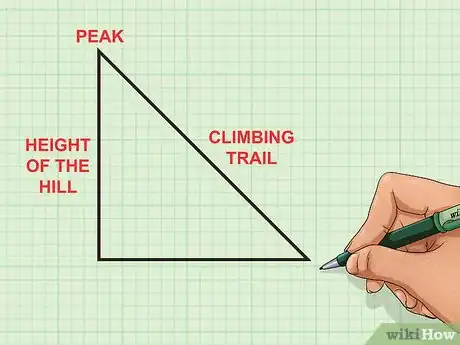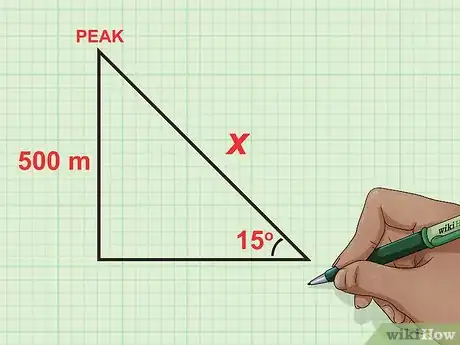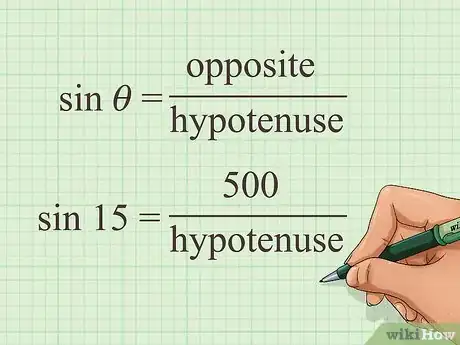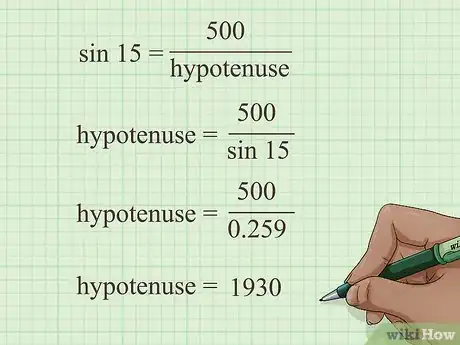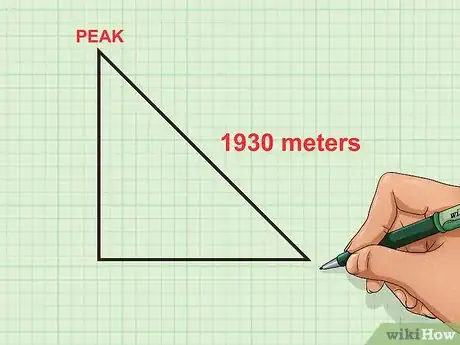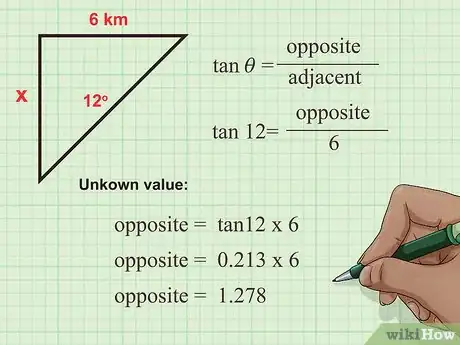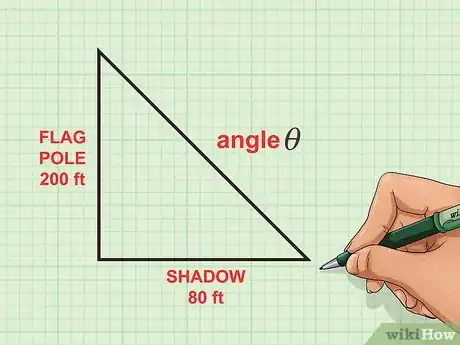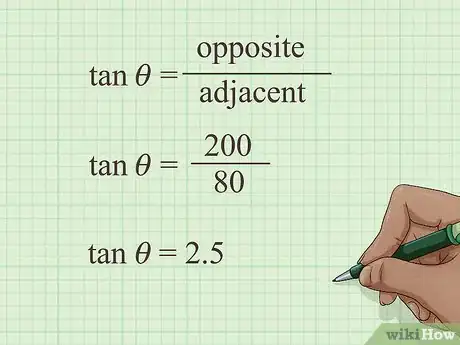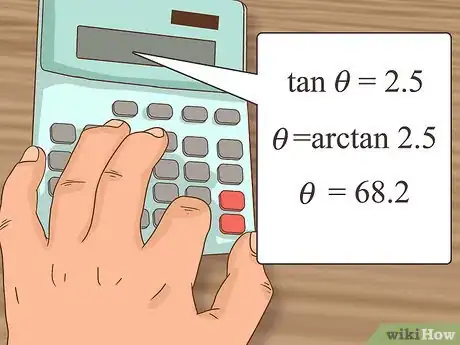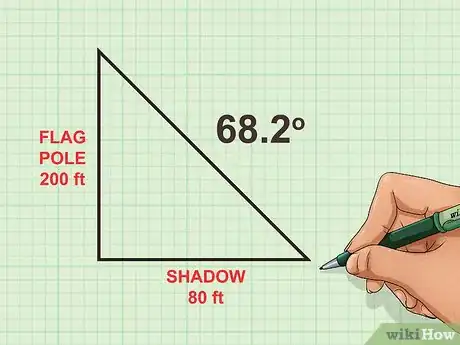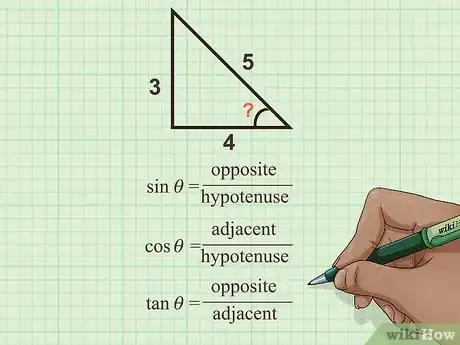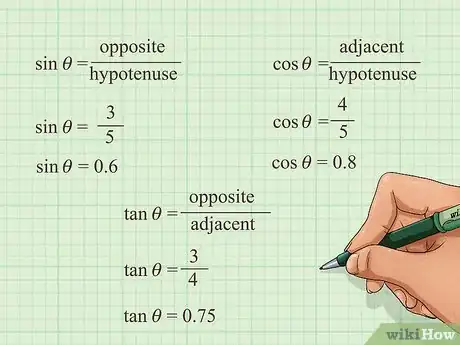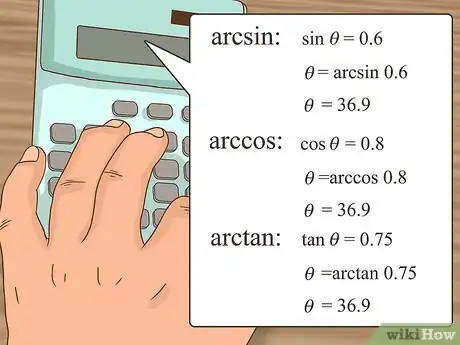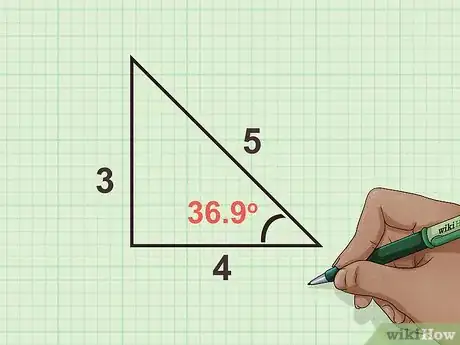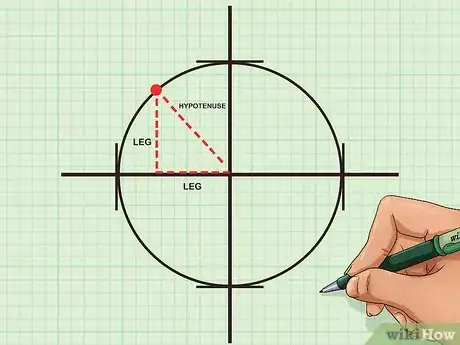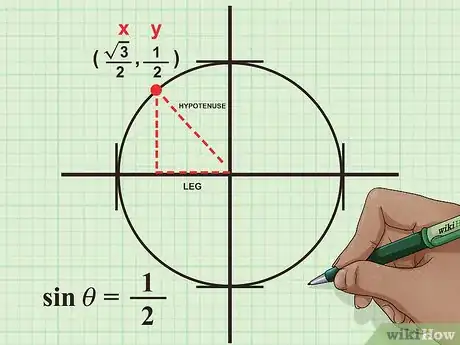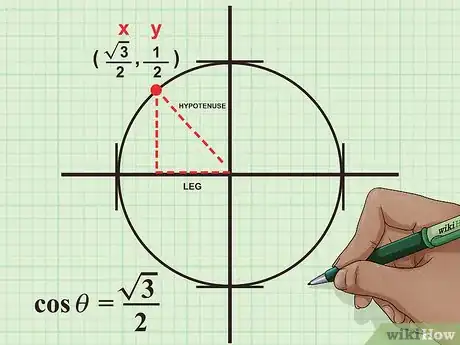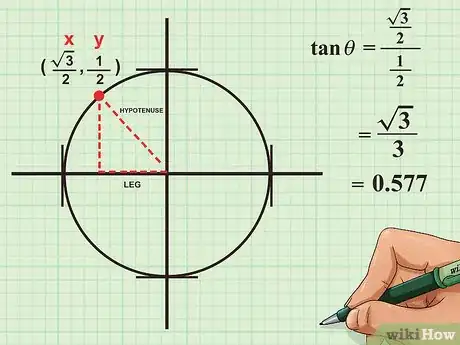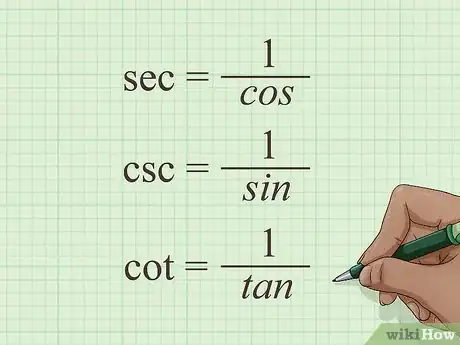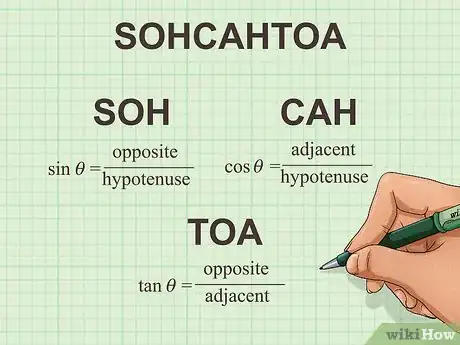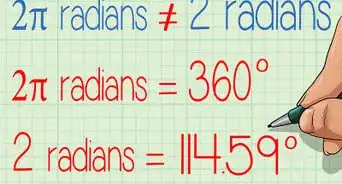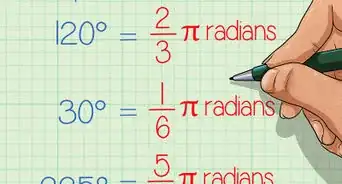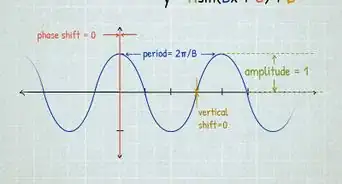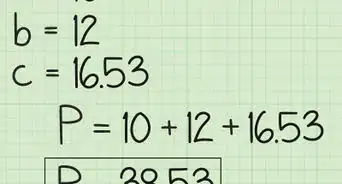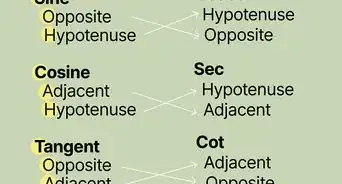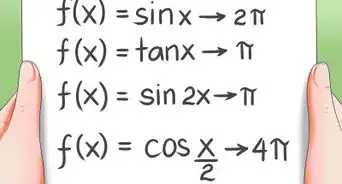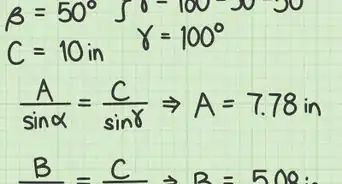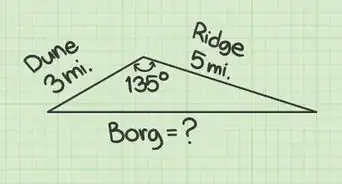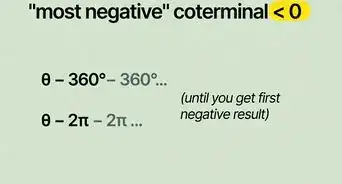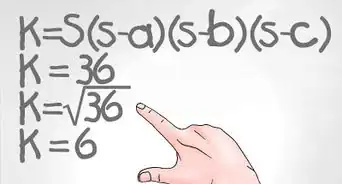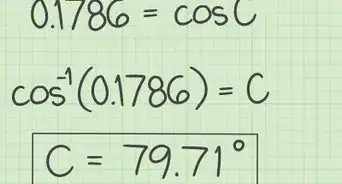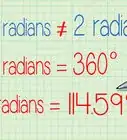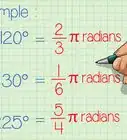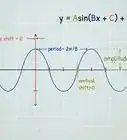This article was co-authored by Mario Banuelos, PhD. Mario Banuelos is an Assistant Professor of Mathematics at California State University, Fresno. With over eight years of teaching experience, Mario specializes in mathematical biology, optimization, statistical models for genome evolution, and data science. Mario holds a BA in Mathematics from California State University, Fresno, and a Ph.D. in Applied Mathematics from the University of California, Merced. Mario has taught at both the high school and collegiate levels.
This article has been viewed 143,692 times.
Right angled trigonometry is useful when dealing with triangles and is a fundamental part of trigonometry in general. Using the ratios that come from the right triangle, and understanding the application of the unit circle, you can solve a wide variety of problems involving angles and lengths. You need to develop a system of modeling a problem with a right triangle. Then select the best trigonometric relationship to solve your problem.
Steps
Using Trigonometry Functions to Measure Distances
-
1Set up a right triangle model. Trigonometry functions can be used to model real world situations involving lengths and angles. The first step is to define the situation with a right triangle model.[1]
- For example, suppose you have the following problem:
- You are climbing a hill. You know that the peak of the hill is 500 meters above the base, and you know that the angle of the climb is 15 degrees. How far must you walk to reach the top?
- Sketch a right triangle and label the parts. The vertical leg is the height of the hill. The top of that leg represents the peak of the hill. The angled side of the triangle, the hypotenuse, is the climbing trail.
- For example, suppose you have the following problem:
-
2Identify the known parts of the triangle. When you have your sketch and have labeled the parts of it, you need to assign the values that you know.
- On the problem of the hill, you are told that the vertical height is 500 meters. Mark the vertical leg of the triangle 500 m.
- You are told that the climbing angle is 15 degrees. This is the angle between the base (bottom leg) of the triangle and the hypotenuse.
- You are asked to find the distance of the climb, which is the length of the hypotenuse of the triangle. Mark this unknown as .
Advertisement -
3Set up a trigonometry equation. Review the information that you know and what you are trying to learn, and choose the trigonometry function that links those together. For example, the sine function links an angle, its opposite side and the hypotenuse. The cosine function links an angle, its adjacent side and the hypotenuse. The tangent function links the two legs without the hypotenuse.
- In the problem with the hill climb, you should recognize that you know the base angle and the vertical height of the triangle, so this should let you know that you will be using the sine function. Set up the problem as follows:[2]
-
4Solve for your unknown value. Use basic algebraic manipulation to rearrange the equation to solve for the unknown value. You will then use either a table of trigonometric values or a calculator to find the value of the sine of the angle that you know.[3]
- To find the length of the hill climb, solve the equation for the length of the hypotenuse.
- To find the length of the hill climb, solve the equation for the length of the hypotenuse.
-
5Interpret and report your result. With any word problem, getting a numerical answer is not the end of the solution. You need to report your answer in terms that make sense for the problem, using the proper units.[4]
- For the hill problem, the solution of 1930 means that the length of the climb is 1930 meters.
-
6Solve another problem for practice. Consider one more problem, set up a diagram, and then solve for the unknown length.[5]
- Read the problem. Suppose a coal bed under your property is at a 12 degree angle and comes to the surface 6 kilometers away. How deep do you have to dig straight down to reach the coal under your property?
- Set up a diagram. This problem actually sets up an inverted right triangle. The horizontal base represents the ground level. The vertical leg represents the depth under your property, and the hypotenuse is the 12 degree angle that slopes down to the coal bed.
- Label the known and unknown values. You know that the horizontal leg is 6 kilometers (3.7 mi), and the angle measurement is 12 degrees. You want to solve the length of the vertical leg.
- Set up a trigonometry equation. In this case, the unknown value that you want to solve is the vertical leg, and you know the horizontal leg. The trigonometry function that uses the two legs is the tangent.
- Solve for the unknown value.
- Interpret your result. The lengths in this problem are in units of kilometers. Therefore, your answer is 1.278 kilometers (0.794 mi). The answer to the question is that you must dig 1.278 kilometers (0.794 mi) straight down to reach the coal bed.
Using Inverse Functions to Calculate Angles
-
1Read the problem with the unknown angle. Trigonometry can also be used to calculate angle measurements. The procedure is similar, but the problem will ask for the measurement of an unknown angle.
- Consider the following problem:
- At a certain time of day, a 200 foot high flag pole casts a shadow that is 80 feet long. What is the angle of the sun at this time of day?
- Consider the following problem:
-
2Sketch a right triangle and label the parts. Remember that trigonometry problems are based on the geometry of right triangles. Sketch a right triangle to represent the problem, and label the known and unknown values.
- For the flag pole problem, the vertical leg is the flag pole itself. Label its height 200 feet. The horizontal base of the triangle represents the length of the shadow. Label the base 80 feet. The hypotenuse, in this case, does not represent any physical measurement but is the length from the top of the flag pole to the end of the shadow. This will provide the angle that you want to solve. Mark this angle, between the hypotenuse and the base, angle .
-
3Set up a trigonometry equation. You need to review which parts of the triangle you know and which you need to solve. This will help you choose the correct trigonometry function to help find the unknown value.
- For the flag pole, you know the vertical height and the horizontal base, but you do not know the hypotenuse. The function that uses the ratio of the two legs is the tangent.
- Set up a tangent equation as follows:
-
4Use the inverse trigonometry function to solve the angle measurement. When you need to find the measure of the angle itself, you will need to use what is called the inverse trigonometry function. The inverse functions are referred to as “arc” functions. These are arcsin, arccos, and arctan.
- On a calculator, these functions appear as , and . You will enter the value and then press the appropriate button, and you will get the measure of the angle. Some calculators differ. On some, you will enter the value first, and then the arctan button. On some, you enter the arctan and then the value. You will need to determine which process works for your calculator.
- On a calculator, these functions appear as , and . You will enter the value and then press the appropriate button, and you will get the measure of the angle. Some calculators differ. On some, you will enter the value first, and then the arctan button. On some, you enter the arctan and then the value. You will need to determine which process works for your calculator.
-
5Interpret your result. Because you were solving for an angle measurement, the unit of your result will be in degrees. Check to see that your answer makes sense.
- Based on this solution, the angle between the earth and the sun is 68.2 degrees. At noon, the sun is directly overhead, which would be an angle of 90 degrees, so this solution seems reasonable.
-
6Set up another problem with an unknown angle. Anytime the angle measure is the unknown factor, you will use an inverse trigonometry function. The procedure is always generally the same.
- Read the problem. A right triangle with legs that are 3 inches and 4 inches long has a hypotenuse that is 5 inches long. What is the measure of the angle opposite the 3 inch leg?
- Sketch the problem. In this case, the problem is simply about the measurements of a triangle. Sketch a right triangle and label the information that you know. One leg is 3, the other leg is 4, and the hypotenuse is 5. The unknown angle, for this problem, is the acute angle opposite the 3 inch leg.
- Set up a trigonometry equation. In this case, because you know all three sides of the triangle, you actually have a choice of functions. You have the data you need to use any one of the functions sin, cos or tan, as follows:
-
7Insert the known values and solve for the unknown angle. In this case, continue solving using all three functions to see, eventually, that the three different functions all reach the same conclusion for the value of the angle .
- First set up a solution with the function:
- Next, set up a solution with the function:
- Finally, set up a solution with the function:
- First set up a solution with the function:
-
8Use a calculator or trigonometry table to find the arc-function values to solve the measure of the angle.
- Find the measure using :
- Find the measure using :
- Find the measure using :
- Find the measure using :
-
9Review your results. In this problem, because you began with an angle and the measurements of all three sides, you were able to solve the problem in three different ways. Any one of them alone would have been sufficient to find the answer. By solving all three, you see that the solution is the same either way. In this case, the chosen angle is 36.9 degrees.
Defining the Basic Functions
-
1Understand the unit circle. Trigonometry is based on the mathematical concept of the unit circle. This is a circle drawn on the x-y coordinate plane, with its center at (0,0), with a radius of 1. By setting the radius equal to 1, the trigonometric functions can be measured directly.[6]
- If you envision a unit circle, any point on that circle establishes a right triangle. From a selected point on the circle, draw a vertical line directly to the x-axis. Then from that point on the x-axis, draw a horizontal line connecting to the origin. These two lines, the vertical and the horizontal, serve as the legs of a right triangle. The radius of the circle that connects the point on the circle to the center at the origin is the hypotenuse of the right triangle.
- Trigonometric functions still apply to triangles and lengths other than 1, but setting the radius equal to 1 makes calculating the ratios more direct.
-
2Learn the sine relationship. The sine function is the ratio of the leg opposite a chosen angle to the hypotenuse of the right triangle. On the unit circle, the sine is a way of measuring the vertical distance from the x-axis to the designated point. This is another way of saying that it is the y-coordinate of the chosen point.[7]
- The sine of an angle is commonly abbreviated as “sin.” The angle of measurement is often labeled , by convention, so you say you are measuring or .
- For example, if you select an angle, called , of 30 degrees at the center of the unit circle, this would mark a point on the circle with coordinates . You can then say that .[8]
-
3Review the cosine function. The cosine function is the ratio of the leg adjacent to the chosen angle divided by the hypotenuse of the right triangle. On the unit circle, the cosine is the length of the horizontal leg, which is also the x-axis coordinate of the point on the circle.[9]
- The cosine of an angle is commonly abbreviated as “cos.” You say you are measuring or .
- For example, if you select an angle of 30 degrees at the center of the unit circle, this would mark a point on the circle with coordinates . You can then say that .[10]
-
4Understand the tangent function. The third common trigonometric function is the tangent. The tangent is the ratio of the two legs of the right triangle to each other, without reference to they hypotenuse. Specifically, for a chosen angle of a right triangle, the tangent is found by dividing the length of the leg opposite to the chosen angle over the leg adjacent to the chosen angle. On the unit circle, the tangent is equal to the y-coordinate divided by the x-coordinate.[11]
- The tangent function is often abbreviated as “tan.” For a selected angle , you say you are measuring or .
- For the example of an angle of 30 degrees at the center of the unit circle, recall that the coordinates are . You can find the tangent by dividing the sine (y-coordinate) by the cosine (x-coordinate) as follows:
- .[12]
- Note that reporting the result in terms of a fraction with the square root, such as is generally considered more precise and more accurate than rounding to a decimal like 0.577. For practically purposes, a three-place decimal may be acceptable.
-
5Review the other ratios. Occasionally, you may need alternate ratios than the cosine, sine and tangent. These alternative functions are inverses of the first three. They are less commonly used in basic calculations. However, in more advanced trigonometric work, they become essential. These functions are:[13]
- Secant. This is abbreviated as “sec” and is equal to .
- Cosecant. The cosecant is abbreviated as “csc” and is equal to .
- Cotangent. The cotangent is abbreviated as “cot” and is equal to .
-
6Learn the mnemonic device SOHCAHTOA. When trying to remember the ratios of the primary functions sin, cos and tan, many students use the memory tool “SOHCAHTOA.” When broken into its parts, it provides the ratios as follows:
- SOH stands for the initials of sin, opposite, hypotenuse, and calls to mind the ratio:
- CAH stands for the initials of cos, adjacent, hypotenuse, as follows:
- TOA stands for the initials of tan, opposite, adjacent, and represents the ratio:
- SOH stands for the initials of sin, opposite, hypotenuse, and calls to mind the ratio:
Community Q&A
-
QuestionWhy do we use only right angled triangles in trigonometry?
 Community AnswerRight triangles model the horizontal and vertical components of the angle at the center of the unit circle. (See discussion in the article.) In more advanced trigonometry, you can apply some rules to non-right triangles.
Community AnswerRight triangles model the horizontal and vertical components of the angle at the center of the unit circle. (See discussion in the article.) In more advanced trigonometry, you can apply some rules to non-right triangles. -
QuestionWhen they ask me what is the cosine of an angle and the angle is given with the triangle's leg lengths what do I use?
 Community AnswerSee the article. The cosine of an angle is found by dividing the length of the side opposite the angle, divided by the hypotenuse.
Community AnswerSee the article. The cosine of an angle is found by dividing the length of the side opposite the angle, divided by the hypotenuse. -
QuestionHow do I find the base of a right triangle?
 Community AnswerThe base of a right triangle is just a matter of perception or alignment. Usually, the base is the horizontal leg. However, if you envision turning or tilting the triangle, then the other leg can become the base. It is relevant to the direction you are looking or the angle you need to measure. Notice that the ratios for sin, cos and tan do not use the vocabulary of the "base" and "height." Instead, they refer to the position of the legs in relation to the angles, as adjacent, opposite or hypotenuse.
Community AnswerThe base of a right triangle is just a matter of perception or alignment. Usually, the base is the horizontal leg. However, if you envision turning or tilting the triangle, then the other leg can become the base. It is relevant to the direction you are looking or the angle you need to measure. Notice that the ratios for sin, cos and tan do not use the vocabulary of the "base" and "height." Instead, they refer to the position of the legs in relation to the angles, as adjacent, opposite or hypotenuse.
References
- ↑ http://serc.carleton.edu/mathyouneed/trigonometry/trigsp.html
- ↑ http://serc.carleton.edu/mathyouneed/trigonometry/trigsp.html
- ↑ http://serc.carleton.edu/mathyouneed/trigonometry/trigsp.html
- ↑ http://serc.carleton.edu/mathyouneed/trigonometry/trigsp.html
- ↑ http://serc.carleton.edu/mathyouneed/trigonometry/trigsp.html
- ↑ http://math2.org/math/algebra/functions/sincos/definition.htm
- ↑ http://math2.org/math/algebra/functions/sincos/definition.htm
- ↑ http://math2.org/math/trig/tables.htm
- ↑ http://math2.org/math/algebra/functions/sincos/definition.htm
